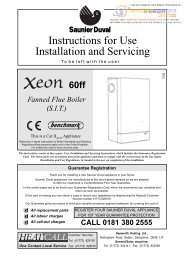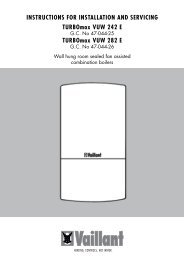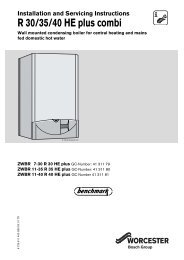Ferroli-Tempra-Installation-manual. - Heatingspares247.com
Ferroli-Tempra-Installation-manual. - Heatingspares247.com
Ferroli-Tempra-Installation-manual. - Heatingspares247.com
- No tags were found...
Create successful ePaper yourself
Turn your PDF publications into a flip-book with our unique Google optimized e-Paper software.
TEMPRAWall MountedFan FlueSystem boilerAppr. nr. B 94.04 A - CE 0063 AQ 2150Phone numbers:Installer ____________________________Service Engineer _____________________Serial N° ____________________________Wall mounted fannedflue boilerINSTALLATION ANDUSE INSTRUCTIONSPlease read these Instructionsthoroughly before usingthe applianceThese Instructions must be left with the appliance User.
1. GENERAL DESCRIPTION AND INFORMATION1.1 Information1. <strong>Installation</strong> must be carried out by a competent person, and in accordance with the relevantrequirements of the current issues of:A. Gas Safety (<strong>Installation</strong> & Use) Regulations. 1994B. Building Regulations.C. Building Standards (Scotland) Regulations.D. I.E.E. Wiring Regulations.E. Bye-laws of the local water undertaking.Guidance on <strong>Installation</strong> is provided in this booklet, but due account must be taken of the detailedrecommendations of the current issues of:BS 5440 Part 1 2000: Flues.BS 5440 Part 2 1989: Air supply.BS 6798:<strong>Installation</strong>.BS 5449:Pumped systems.BS 5546:Domestic hot water.BS 6700:Water supply.BS 6891:Gas supply.BS 7074 Part 1: Expansion vessels.BS 7593:Treatment of water in domestic hot water central heating systems.For installation in timber framed buildings, refer to the British Gas Publication Guide for gasinstallation in timber framed housing - REF DM2.2. It is essential that the boiler be installed strictly in accordance with these Instructions and thedocuments, detailed above.3. To avoid the possibility of injury, care must be taken when handling sheet metal components.1.2 IntroductionThe TEMPRA Boiler is a “room-sealed” appliance: it takes in the air required for combustion andencloses all the combustion products in an hermetic compartment. The discharge of fumes andintake of combustion air are managed through air/flue pipes that may be run horizontally in alldirections, or through a concentric flue running vertically or horizontally.The main components of the boiler are:- A compact heat exchanger in copper, formed by four pipes with external finning and internalturbulence activators.- A combustion chamber insulated to reduce heat loss and thus improve efficiency.- Nine stainless steel burners, an oxidation- and thermal shock-resistant material specially developedfor this product.- A fan to discharge combustion products and draw in combustion air.TEMPRA3
2.03. Flow diagram295168731275225192224/822051434456932814 49798 145 63°C9849Outletpressurereliefvalve7Fig. 25 - Room sealed compartment7 - Gas supply8 - Central Heating flow outlet9 - Central Heating return inlet14 - Safety valve16 - Fan19 - Combustion chamber20 - Burner box22 - Burner24/82 - Ignition/flame sensing electrode25 - Pilot burner27 - Copper heat exchanger29 - Tube flue outlet31 - Flue collector32 - Pump43 - Air pressure switch44 - Gas valve49 - Overheat cut-off thermostat (reset)51 - Central heating frost thermostat52 - Central heating limit thermostat56 - Expansion vessel63 - C.H. boiler thermostat87 - Gas pressure test point98 - Main switch145 - Pressure gaugesTEMPRA7
120 43CMinimum dimensions offlue terminal positionsDimensionsTerminal position(kW input expressed in net)Balanced flues roomsealedOpen fluesNatural Fanned Natural Fanneddraught draught draught draughtAaDirectly below an opening, air brick, (0-7 kW)300 mm 300 mm Not allowed 300 mmopening windows, etc. (>7-14 kW)600 mm(>14-32 kW)(>32-70 kW)1500 mm2000 mmBaAbove an opening, air brick, (0-7 kW)300 mm 300 mm Not allowed 300 mmopening windows, etc. (>7-14 kW)300 mm(>14-32 kW)(>32-70 kW)300 mm600 mmCaHorizontally to an opening, air brick, (0-7 kW)300 mm 300 mm Not allowed 300 mmopening windows, etc. (>7-14 kW)400 mm(>14-32 kW)(>32-70 kW)600 mm600 mmDEFGHIJKLMNOPBelow gutters, soil pipes or drain pipesBelow eavesBelow balconies or car port roofFrom a vertical drain pipe or soil pipeFrom an internal or external cornerAbove ground roof or balcony levelFrom a surface facing the terminal(also see 6.1.2)From a terminal facing the terminalFrom an opening in the car port ( e.g. door,window) into the dwellingVertically from a terminal on the same wallHorizontally from a terminal on the same wallFrom the wall on which the terminal is mountedFrom a vertical structure on the roof300 mm300 mm600 mm300 mm600 mm300 mm600 mm600 mm1200 mm1500 mm300 mmN/AN/A75 mm200 mm200 mm150 mmb300 mm300 mm600 mm1200 mm1200 mm1500 mm300 mmN/AN/ANot allowedNot allowedNot allowedNot allowedNot allowedNot allowedN/AN/AN/AN/AN/AN/ASee Table 2and Fig. 6b75 mm200 mm200 mm150 mm200 mm300 mm600 mm1200 mm1200 mm1500 mm300 mm50 mmN/AQ Above intersection with roofN/A N/A See Table 2 150 mmand Fig. 4NOTE N/A = Not applicablea In addition, the terminal should not be nearer than 150 mm (fanned draucht) or 300 mm (natural draught) to an opening in the building fabric formed for the purpose of accommodatinga built-in element such as a window frame, (see Figure C2). Separation distances are linked to the rated heat inputs as shown.b This dimension may be reduced to 75 mm for appliances of up to 5 kW heat input.Minimum Clearance mm20050min.8225 mm25 mm600**200 minFig. 4NOTES** Access to the front of the boiler must be available for maintenance (min. 600 mm).TEMPRA9
Sealed system - “Y” PlanDomesticCylinder3 port motorisedvalvesBoilerFig. 5Filling pointBy PassSealed system - “S” PlanDomesticCylinder2 port motorisedvalvesBoilerFig. 6Filling pointBy PassNOTE: A bypass must be fitted to ensure a minimum flow rate of 6 l/min. through the boiler.ApprovedfillingloopKey1. Filling point C.H.2. Temporary connection3. Cold water supplyFig. 7TEMPRA11
3.9 Built-in Central Heating Water Circulating PumpThe pump head available for circulating the water is given in fig. 8.N.B. - The pump is factory set at position 3. The pump is a Grundfos type UPS 15-50 series.Grunfos Pump performance graphNote - Minimum flow through boiler heat exchanger at any time should not fall below 6 litres perminute.If required an additional expansion vessel may be fitted to the central heating return inlet.If the total volume of water in the system exceeds 40 litres an additional expansion vesselmust be fitted to the central heating return inlet.Pump performance curve Grundfos UPS 15-501 2 3 Speed settingsA Boiler pressure dropB Max. available pump head C.H.Fig. 8SAFETY VALVESETTING (bar)3.0VESSEL CHARGEPRESSURE (bar)0.5 1.0 1.5INITIAL SYSTEMPRESSURE (bar) 1.0 1.5 2.0 1.5 2.0 2.0TOTAL WATERCONTENT of SYSTEM EXPANSION VESSEL VOLUME (litres)LITRES25 3.5 6.5 13.7 4.7 10.3 8.350 7.0 12.9 27.5 9.5 20.6 16.575 10.5 19.4 41.3 14.2 30.9 24.8100 14.0 25.9 55.1 19.0 41.2 33.1125 17.5 32.4 68.9 23.7 51.5 41.3150 21.0 38.8 82.6 28.5 61.8 49.6175 24.5 45.3 96.4 33.2 72.1 57.9200 28.0 51.8 110.2 38.0 82.4 66.2For syst. volumes other thanthose given above, mult. the syst.volume by the factor across0.140 0.259 0.551 0.190 0.412 0.33SIZING OF ADDITIONAL EXPANSIONVESSELS:Deduct from the value given in the table the6 litre vessel supplied.Note1. Fill C.H. installation to min. 1.5 bar.2. Select by preference the expansion vesselfor increased system pressure of 2.0 bar3. Expansion vessel must be fitted to CentralHeating Return Inlet4. The standard 6 litres expansion vessel ischarged to 1 barFig. 9TEMPRA12
4. INSTALLATION4.1 UnpackingThe appliance is delivered in 2 cartons.4.1.1 The large carton contains the boiler, and the <strong>Installation</strong>/Servicing and Users Instructions.4.1.2 The second carton contains the wall fixing bolts (x2), flue assembly, and boiler bend, gas cockand 3/4” x 1/2” bush.4.2 Wall mountingAfter selecting a suitable place for the boiler, mark location for fixing holes. Using 8 mm drill, drill60 mm deep holes to accept fixing bolts and insert. Tighten nuts until secure, then remove nutsleaving studs protruding, hang boiler and refits nuts to secure.ccdFig. 10TEMPRA13
4.3 Preparing the flue assemblyThe boiler is supplied with 0.75 m of concentric flue which can be run from either side or to the backof the appliance. If a longer flue is required 2 m and 3 m lengths are avaiable.An example of using the concentric flue.Outlet and inletthrough a building wallMAX 3mMaximum permitted length forconcentric flue to be run is 3 m.Fig. 11Flue connectionDrawing below showshow concentric flueshould be assembled -the main points being:25-30 mm Ø260Ø11. Inner flue pipe(alluminium) needsto be 85 - 90 mmlonger than plasticair intake pipe2. The air intake(plastic) pipe onlybutts to the elbow3. Care must be takennot to dislodge “O”ringsChamfer outer edge ofaluminium pipe toavoid dislodging "O" rings"O" ringsLA=L+(85-90)mmClamp detailØ2Ø1Ø1=100Ø2=60Fig. 12TEMPRA14
6. ELECTRICAL SUPPLY AND CONNECTIONSAll electrical installation work must be carried out by a qualified electrician, and all work shall be inaccordance with the current issue of the IEE wiring regulations.Supplied for use on 230 V ~ 50 Hz supply, protected by a 3 Amp fuse.The boiler must be earthed.The method of connection to the mains supply must allow complete isolation from that supply eitherby:a) Use of 3 A fused double pole switch having a contact separation of at least 3 mm. Such a switch mustsupply the appliance and immediate control circuits only (eg room thermostat, programmer etc.)ORb) Use of an unswitched shuttered socket outlet and 3 A fused 3 pin plug both complying with BS 1363.All external cables must be suitable for mains voltage and should be PVC insulated cable atleast 0.75 mm 2 (24/0.2 mm), to BS 6500.All external circuits for the control of the boiler must be wired and isolated from the same isolator asthat which serves the boiler.6.1 Electrical connection1. The TEMPRA boiler requires a permanent live supply to the appliance (live, neutral and earth)together with a switched line from the system controls to operate the burner.2. When using external controls remove link wire betwen terminals 4 -5.3. Run live connection from terminal 4 to external switch controls and return switch line intoterminal 5.1 2LN34 56 7 8 9 10 11 12SLLN230 V ~3 Amp fuseExternal switchcontrolsElectricalcontrol boxFig. 18WARNING: If external controls are fitted to the system, check terminals 1, 2, 4, and 5 to ensurethey are voltage free prior to working on the boiler.TEMPRA16
6.2 Electrical connections diagram248312 11 10 9 8 7 6 5 4 3 2 143 16NOCNC98 1762 41 3263C1Wiring 43C = BrownNO = BlueNC = Black16. Fan24. Spark electrode32. Central heating pump43. Air pressure switch50. Central heating limit thermostat51. Central heating frost thermostat63. C.H. boiler thermostat72. External controls83. Full sequence automatic control98. Switch176. Overheat CUT-OFF thermostatLL N230V50HzN 4 5 6 7 8 9 10 11 1272 32 50516.3 General wiring diagramL2 4114572SL11512C16312105016. Fan24. Spark electrode32. Central heating pump43. Air pressure switch50. Central heating limit thermostat51. Central heating frost thermostat63. C.H. boiler thermostat72. External controls83. Full sequence automatic control98. Switch176. Overheat CUT-OFF thermostatN230 V ~3 Amp fuse9813326879176248312S.4585 D1003 111 2 3 4 5 6 7 8 9 10NC NOC43 16TEMPRA17
15. CommissioningCarry out preliminary electrical system checks i.e. EARTH CONTINUITY, RESISTANCE TO EARTH,SHORT CIRCUIT AND POLARITY using a suitable test meter.1. Remove the outer case and lower cover.2. Test for gas soundness up to the boiler service cock - BS 6891.3. Flush the system cold, without the boiler in circuit.4. Fill the complete circuit and vent the system, fill to about a=1.5 bar at this stage.5. Check the system for water soundness, rectifying any leaks.6. Reduce the pressure to the approximate initial design pressure.7. Open all radiator valves.8. Loosen the screw within the pressure test point on the burner supply pipe and attach a suitablepressure gauge.9. Open the boiler service cock.10. Open all doors and windows, loosen the screw in the inlet pressure test point, and purge the gassupply BS 6891. Retighten the screw. Allow gas to disperse.11. Set any external control to an ON condition, and turn the thermostat knob to maximum.12. Turn on the electricity supply. Check that the pump runs.13. A continuous spark will light the pilot (viewed through window) and the main burner.14. Heat Input Adjustment. The Input is pre-set to 16.7 kW but can the adjusted to any value in therange quoted in Technical Data - the burner pressure must always be checked anyway.Remove the cap from the adjustment screw.CH 2 HEAT INPUT BURNER PRESSURE CH 1 HEAT OUTPUT(Gross) kW mbar set to kWMAX 21.6 15 — 17.6MED 16.7 8 — 13MIN 12.8 5 — 9.718Burner pressure to C.H. Heat Output 1 / Heat Input 2161412mbar1081264200 2 4 6 8 10 12 14 16 18 20 22 24kWTEMPRA18
181017Key10. Inlet pressure test point17. Adjustment screw burner pressure (turn clockwise to increase pressure)18. Burner pressure test point15. After 10 minutes, adjust the heat input to the required value. (Anticlockwise to decrease).Replace the cap.16. NOTE - If the required pressure cannot be obtained, the inlet working pressure should be checked(20 mbar is required with burner on!)17. Allow the system to reach heated equilibrium. On sealed systems check that the pressure does notexceed 2.6 bar (in which case a larger expansion vessel will be needed).18. Turn off burner.19. Flush the system whilst hot, and refill.20. Remove the pressure gauge, tighten the screw.21. Relight and check for gas soundness.22. Mark the Data Badge to indicate the set heat input.23. Replace the lower cover and outer case.24. Adjust the thermostat control knob to the required setting.25. Hand over to the user:a) Explain the function and control of the boiler, including any external controls.b) Advise against obstruction of purpose provided ventilation, and of the flue terminal.c) Give advice on frost protection of parts.d) Advise arrangement of an annual Service Contract.e) Hand all Instructions and literature to the user.TEMPRA19
Phone numbers:InstallerService EngineerCod. 3540982/0 - 06/2001BECAUSE OF OUR CONSTANT ENDEAVOUR FOR IMPROVEMENT DETAILSMAY VARY SLIGHTLY FROM THOSE QUOTED IN THESE INSTRUCTIONS.ALL SPECIFICATIONS SUBJECT TO CHANGELichfield Road, Branston Industrial Estate, Burton Upon Trent, Staffordshire DE14 3HDTel. 08707 282 885 - Fax 08707 282 886
















